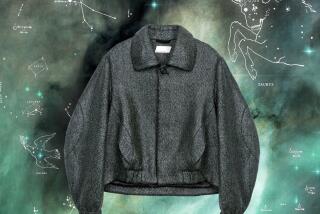Pinning Down an Expert on the Art of Packing : When it comes to knowing what to take along, a seasoned traveler favors comfort with style, and reveals how she keeps it simple.
- Share via
“Just a minute!” barked the airport security guard as I grabbed my tote bag from the conveyor belt in Singapore.
My mind raced through the long list of potential violations in that squeaky-clean country. I was not carrying drugs or cigarettes or obscene literature. I had not smuggled in chewing gum, nor had I jaywalked or littered.
“Is that your only one?”
He was pointing to the San Diego Zoo pin on my lapel, a cheery koala in yellow, gray and white. “Yes,” I said. “It’s nice,” he said, and waved me on.
Puzzled, I boarded the plane for Hong Kong.
Had I said “No” and produced another zoo pin, would he have asked for it? And would that be breaking the Singapore law against tipping at the airport?
I’ll never know, yet the incident reminded me not to leave home again without a fistful of souvenir lapel pins. Children love them. And, in many parts of the world, adults will offer to swap pins as if they were business cards.
In Antarctica, early one New Year’s Day, the lone Russian awake at the then-Soviet Union’s Bellingshausen station handed me a rectangular lapel pin with Cyrillic letters on it. His look of anticipation was unmistakable, but I had come onto the icy continent almost empty-handed. I gave him a star-spangled ballpoint pen that I found in a parka pocket.
At the Jean Cocteau Museum on the French Riviera at Menton, a guide offered me a city pin and admired a tiny enamel flower I wore--a violet, it may have been--from the Canadian province of New Brunswick.
The attributes of souvenir pins (some fasten like tie tacks) are many: they’re lightweight, sexless and can be inexpensive as well as non-controversial. Popular sources are zoos, museums, stadiums, universities, amusement parks, national parks and those abundant crafts carts that line the malls of America. Special pins are made for special events: World’s Fairs, Olympics, gala concerts, the arrival of tall ships or giant pandas or the treasures of Tut.
As for what else to pack for a trip, I believe in comfort with style. I don’t expect to be taken for a native in every port, but I like to be inconspicuous.
That’s one reason that, like most locals, I don’t wear jogging shoes in London or Paris or Rome, except when jogging--OK, striding swiftly. One spring morning, in a warm-up suit and dark glasses, I slipped out of Paris’ George V hotel at something after 6 a.m. and walked to--and through--the Arc de Triomphe. There was little traffic on the Champs-Elysees, only a few prowling taxis; the side streets were quiet, leafy with plane trees, and smelled of freshly brewed coffee and freshly baked bread. I sat at a sidewalk table and had what in America is called a continental breakfast, for a fraction of the cost of room service.
Flat, dark shoes with rubber soles work well on most capital cobbles--and the jogging shoes are always nearby for the countryside, or for emergencies such as hard, punishing museum floors.
For hot climates and resorts, a pair of sandals--or canvas espadrilles--prove forgiving when your feet swell. For other shoes, remember that suede gives more and scuffs less than regular leather. Make sure your shoes are broken in; I have a relative who landed in Europe before testing her new “guaranteed comfortable” dress pumps made by a sports-shoe company. To keep going, she reverted to tennis shoes.
Other wardrobe rules can be simple--if you like it simple: build around two basic colors (black and khaki, or camel, are my neutral favorites--they’re already the color of dirt and dust). Mix in some tops of white or ivory, and a favorite contrasting shade (at the moment I lean toward sage green). A bold pocket handkerchief or scarf can provide a handsome accent. So can a belt, or a watchband, or bangles.
Black at night is a safe bet, especially in foreign cities. You look around a theater crowd in London or a restaurant in Stockholm and see little else. Cruises are an exception, especially in warm waters; bright clothes abound on deck and on the dance floor.
Skirts or pants with at least partial elastic waistbands are accommodating, and available in more styles and prices than a few years back when elastic meant Santa Fe broom skirts or square dancing.
I like long cotton skirts with pockets; I like jackets with pockets. I bought a cotton “traveler’s vest” from Banana Republic a couple of seasons ago that is nothing but pockets, and it has traveled as much as I have, often replacing both purse and camera case.
My latest travel essential--no matter the destination--is a dime-store version of the French market bag. Empty, this net sack weighs next-to-nothing, yet it can hold newspapers, fresh peaches, bars of herbal soap, film, maps, a bottle of water, a sweater and the souvenirs that accrue when you start talking to merchants and bus drivers who want to trade stories or pins.
More to Read
Sign up for The Wild
We’ll help you find the best places to hike, bike and run, as well as the perfect silent spots for meditation and yoga.
You may occasionally receive promotional content from the Los Angeles Times.






